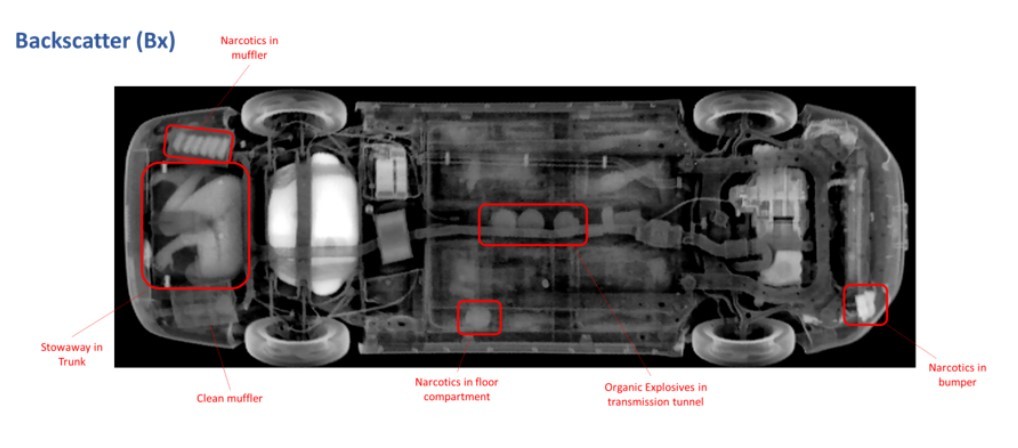Crossing international borders involves numerous security measures, and for motorists, a common question arises: Do Cars Get Scanned At Borders? The answer is yes, and this practice is becoming increasingly sophisticated. Border security agencies worldwide utilize advanced scanning technologies to inspect vehicles for contraband, ensuring national security and combating illegal activities. This article delves into the world of vehicle scanning at borders, exploring the technology used, the reasons behind it, and what travelers can expect.
The Necessity of Vehicle Scanning at Border Checkpoints
Vehicle scanning at borders is a critical component of modern border security. The primary goal is to detect and prevent the illegal trafficking of contraband, which can include drugs, weapons, illegal cash, and even human smuggling. Traditional manual inspections, while still in use, are time-consuming and can be less effective at uncovering hidden compartments and concealed items within vehicles. This is where advanced scanning technology plays a vital role, offering a faster and more thorough inspection process.
X-Ray Technology: Seeing Beneath the Surface
One of the most prevalent technologies used for vehicle scanning at border checkpoints is X-ray scanning. Companies like Viken Detection specialize in creating systems that allow border officials to “see through” vehicles without requiring extensive physical searches. These systems often employ under-vehicle inspection technology, which is particularly effective in examining the most challenging areas of a car.
How Under-Vehicle Scanning Works
Under-vehicle inspection systems are designed to scan the undercarriage of vehicles as they drive over them. These systems are often installed flush with the road surface. As a vehicle passes, the scanner generates a detailed image of the vehicle’s undercarriage, including areas like tire wells, bumpers, chassis, and the underbody. Border officers can then review these real-time images for anomalies that might indicate hidden contraband.
Jim Ryan, CEO of Viken Detection, explained that their technology provides a “backscatter view” of the under-vehicle, allowing inspectors to quickly assess potential threats. This technology is particularly valuable because the undercarriage is notoriously difficult to inspect manually, offering numerous hiding places for illicit goods.
Types of Contraband Detected
Vehicle scanners are designed to detect a wide range of contraband. This includes:
- Illegal Drugs: Narcotics are a major concern for border security, and scanners can identify the density variations associated with hidden drugs.
- Weapons: Firearms and explosives pose significant security threats. Scanners can detect metallic and non-metallic weapons concealed within vehicles.
- Cash: Large sums of undeclared currency are often associated with illegal activities. Scanners can help identify bulk cash hidden in vehicles.
- Human Smuggling: While more challenging to detect with current vehicle scanning technology alone, anomalies in vehicle structure or occupancy can raise suspicions and prompt further investigation for potential human smuggling attempts.
Deployment and Effectiveness of Vehicle Scanners
U.S. Customs and Border Protection (CBP) is actively deploying vehicle scanning technology at ports of entry along the Southwest border with Mexico. This initiative is part of a larger border security strategy aimed at enhancing inspection capabilities and streamlining the flow of legitimate traffic. The goal is to significantly increase the percentage of vehicles scanned, targeting a high percentage of both passenger and commercial vehicles.
While security restrictions prevent the disclosure of specific locations, the intention is to equip numerous checkpoints with this technology. CBP aims to balance security effectiveness with operational efficiency, ensuring that inspections are thorough yet do not cause excessive delays for travelers.
Safety Considerations
Concerns about radiation exposure are common when discussing X-ray technology. However, vehicle scanning systems at borders are designed with safety in mind. Viken Detection CEO Jim Ryan emphasizes that the energy emitted by these scanners is low, comparable to or even lower than that of a dental X-ray. This ensures the safety of both the operators and vehicle occupants during the scanning process.
Secondary Inspections: A Multi-Layered Approach
It’s important to note that vehicle scanning is often part of a multi-layered security approach. If a scanner identifies a potential anomaly or something suspicious, the vehicle is typically referred to a secondary inspection area. Here, CBP officers may use handheld scanners, conduct physical searches, and employ other techniques to further investigate. This layered approach maximizes the chances of detecting contraband while minimizing disruptions to regular border crossings.
The Future of Vehicle Scanning at Borders
As technology advances, vehicle scanning at borders is likely to become even more sophisticated. Future developments may include more advanced imaging techniques, artificial intelligence-powered threat detection, and integration with other security systems. The ongoing evolution of these technologies will play a crucial role in enhancing border security effectiveness and adapting to evolving threats.
In conclusion, “Do cars get scanned at borders?” is definitively answered with a yes. Vehicle scanning is an essential and increasingly advanced practice at international borders. Technologies like X-ray scanners, particularly under-vehicle inspection systems, are crucial tools for detecting contraband and ensuring border security. As travelers navigate border checkpoints, understanding the role and purpose of these scans can provide clarity and reassurance about the measures in place to protect national security.

